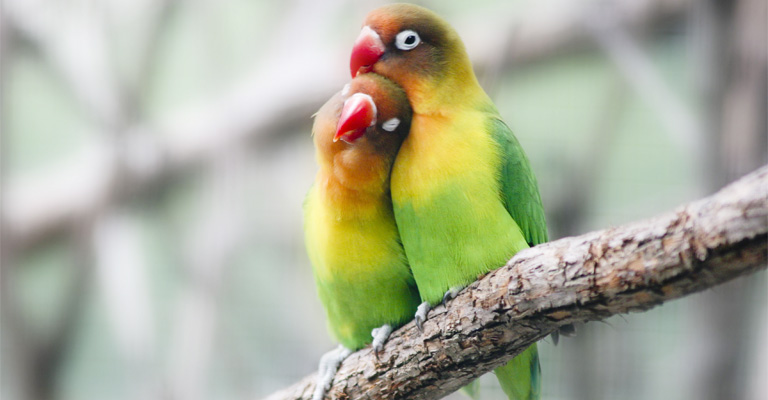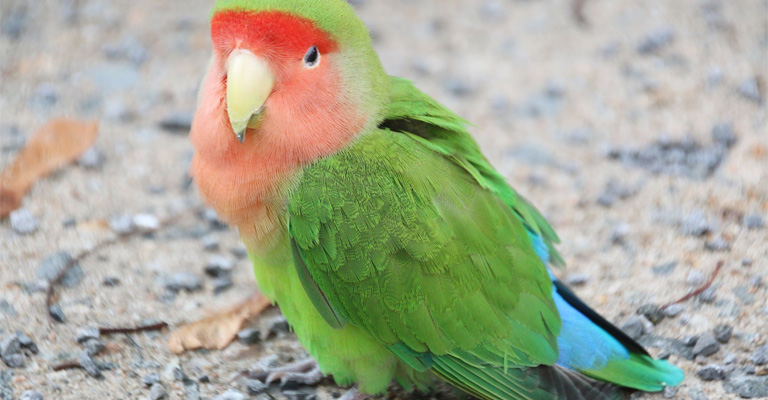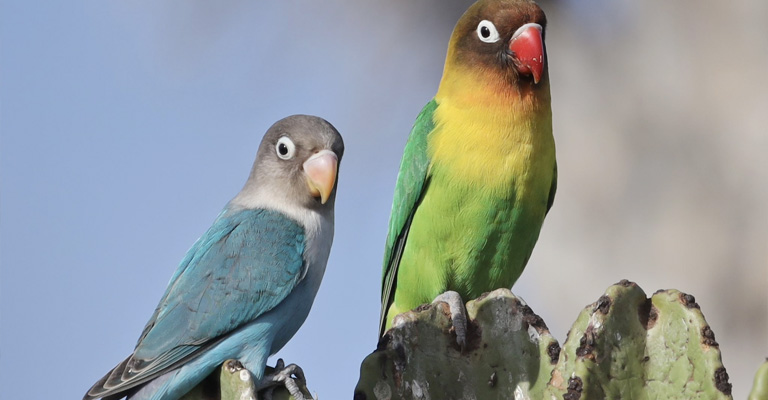Lovebirds, those charming and affectionate parrots known for their inseparable bond, have long fascinated both bird enthusiasts and romantics alike.
These small, colorful creatures are renowned for their deep emotional connections, often forming lifelong partnerships with their mates. The enigmatic phenomenon of lovebirds perishing when separated from their partners stems from the depth of their emotional bonds.
Yet, there exists a poignant and puzzling question that tugs at the heartstrings of many: why do lovebirds die when they are separated from their beloved companions?
In this exploration, we embark on a journey to unravel why do lovebirds die when they are separated. We’ll delve into the science behind their strong emotional attachments, the consequences of forced separation, and the profound implications for these avian species.
Prepare to be captivated by the story of love, loyalty, and the curious fragility of the lovebird’s heart when torn apart from its soulmate.

Why Do Lovebirds Die When They Are Separated?
In this section, we’ll delve into the science behind their strong emotional attachments, the consequences of forced separation, and the profound implications for these avian species.
The Bond Between Lovebirds
Lovebirds, scientifically classified as Agapornis, are a group of parrot species native to Africa. These charming birds are appropriately named for their strong affection for their mates.
In the wild, lovebirds are often seen perched closely together, preening each other’s feathers, and engaging in playful behaviors. In captivity, they can form bonds that are just as strong with their human caregivers or other lovebirds.
These birds are known for their monogamous nature. Once they find a mate, they typically remain devoted to that partner for life.
Their close bond is characterized by constant companionship, mutual grooming, and vocal displays of affection. Lovebirds are also highly social, often forming tight-knit flocks with other lovebird pairs.
The Science Behind Lovebird Attachments
To understand why lovebirds are so deeply attached to their partners, we must look at their biology and social behavior. Lovebirds are among the most social and affectionate of all parrot species.
They have a high level of intelligence and emotional sensitivity, which enables them to form strong emotional connections.
One key factor in their bond is the production of the hormone oxytocin, often referred to as the “love hormone.” Oxytocin plays a crucial role in the formation of social bonds and attachment in animals, including humans.
When lovebirds interact with their mates, whether through grooming, feeding, or simply being in close proximity, oxytocin levels in their brains increase. This hormone reinforces their emotional connection, creating a deep and lasting bond.
Moreover, lovebirds have a strong need for social interaction. In the wild, they rely on their flock for safety, foraging, and companionship.
This social reliance is mirrored in their relationships with their mates or human caregivers. When separated from their partners, lovebirds experience stress and anxiety, which can have profound effects on their health.
The Consequences of Separation

The bond between lovebirds is so strong that forced separation can be devastating for them. When a lovebird is separated from its mate or human caregiver, it can experience a range of physical and emotional distress symptoms:
Stress
Lovebirds are highly sensitive creatures, and the stress of separation can lead to a variety of health issues. Increased stress levels can weaken their immune system, making them more susceptible to illnesses.
Depression
Lovebirds can exhibit behaviors akin to depression when they are separated from their loved ones. They may become lethargic, lose their appetite, and show little interest in their surroundings.
Loneliness
Loneliness is a significant emotional challenge for lovebirds. They thrive on social interaction, and without it, they can become anxious and despondent.
Behavioral Problems
Separated lovebirds may develop behavioral issues such as feather plucking, excessive screaming, or aggression. These behaviors are often a result of the emotional distress they experience.
Shortened Lifespan
In severe cases, the stress and emotional trauma caused by separation can lead to a decline in the lovebird’s overall health and, ultimately, a shortened lifespan.
A Cautionary Tale
The phenomenon of lovebirds dying when separated serves as a cautionary tale for those who keep these birds as pets. While it’s important to provide them with proper care and attention, it’s equally crucial to be aware of the potential consequences of separation.
If a lovebird’s mate or companion passes away, the surviving bird may be at risk of experiencing severe emotional trauma. One approach to mitigating the negative effects of separation is to ensure lovebirds have ample social interaction and mental stimulation.
This can involve spending quality time with them, providing toys and activities, or even considering introducing a new companion if appropriate.
Conservation Implications
Understanding the emotional bonds of lovebirds also has implications for their conservation. In the wild, lovebirds are facing habitat loss and other threats that can disrupt their social structures.
Conservation efforts must consider the importance of maintaining the social and emotional well-being of these birds. Disrupting their flocks or separating bonded pairs can have long-term consequences for their survival.
Should You Replace Lovebird’s Lost Mate?

Losing a mate is a challenging experience for both humans and animals. Lovebirds, renowned for their strong pair bonds and affectionate nature, are no exception.
When one member of a lovebird pair passes away, it raises the question of whether to replace the lost mate. This decision is a complex and emotional one, involving considerations related to the surviving lovebird’s well-being, potential compatibility issues, and the responsibilities of a new addition to the family.
In this exploration, we’ll delve into the factors to weigh when deciding whether to replace a lovebird’s lost mate.
The Grieving Process in Lovebirds
When a lovebird loses its mate, it can go through a grieving process that includes behavioral changes, such as increased vocalizations, decreased appetite, and lethargy.
Like many animals, lovebirds are capable of experiencing grief and loss. These reactions are signs of the emotional impact of losing a lifelong companion.
The Survivor’s Well-being
The emotional health and well-being of the surviving lovebird should be a primary consideration when contemplating whether to replace a lost mate.
Lovebirds are social creatures, and their strong pair bonds provide them with comfort, companionship, and emotional support. For some, the sudden absence of a mate can result in loneliness and stress, leading to a decline in physical health.
Addressing Loneliness
To alleviate the loneliness experienced by a surviving lovebird, introducing a new mate can be a potential solution. A compatible companion can provide emotional support and companionship, helping the grieving bird to heal and adapt to the loss.
Compatibility Matters
It’s essential to carefully consider the compatibility of the new mate with the surviving lovebird.
The personalities, preferences, and temperaments of the birds play a significant role in whether they will form a harmonious pair. A knowledgeable breeder or avian expert can assist in selecting a suitable mate.
Monitoring Behavior
After introducing a new mate, closely monitor the interactions between the surviving lovebird and the newcomer. Positive behaviors such as mutual preening, sharing food, and vocalizing together can indicate a successful pairing.
Considerations Before Introducing a New Mate
Before deciding to replace a lost lovebird mate, there are several important considerations to take into account:
Time Since Loss
Grieving is a personal process that varies from one bird to another. It’s crucial to allow the surviving lovebird ample time to mourn its mate before introducing a new companion. Rushing this process can be stressful and counterproductive.
Compatibility Assessment
Consult with an avian expert to assess the compatibility between the surviving lovebird and a potential new mate. A knowledgeable individual can provide insights into whether the personalities and behaviors of the birds are likely to be compatible.
Health and Quarantine
Ensure that the new lovebird is in good health and free from diseases. Quarantine the new bird for an appropriate period before introducing them to the surviving lovebird to prevent the transmission of illnesses.
Supervised Introduction
When introducing a new mate, do so gradually and under supervision. Allow the birds to get to know each other in a controlled environment to ensure a safe and positive interaction.
FAQs
How long does it take for a lovebird to recover from the loss of its mate?
The mourning process for a lovebird can vary widely from one individual to another. It may take weeks to several months for a mourning lovebird to show signs of recovery.
Is it advisable to introduce a new mate to a mourning lovebird?
Introducing a new mate to a mourning lovebird is a possibility, but it should be approached with caution and after careful consideration. Compatibility between the surviving bird and the potential new mate is essential.
Can grief lead to physical health issues in lovebirds?
Yes, grief can have physical effects on lovebirds. The emotional distress caused by the loss of a mate can weaken the bird’s immune system, making it more susceptible to illness. Common physical symptoms of grief include feather plucking, self-mutilation, and a decrease in overall health.
Should I change my lovebird’s diet during the mourning period?
While grief may result in a reduced appetite in some lovebirds, it’s essential to maintain a balanced diet for your bird. Continue offering a variety of fresh foods, seeds, and pellets. Monitor your lovebird’s eating habits and ensure it remains adequately hydrated.
Can lovebirds recover from grief and lead happy lives after losing a mate?
Yes, lovebirds can recover from grief and lead fulfilling lives after losing a mate. With the right support, time, and understanding, many lovebirds can adapt to life without their companion. Providing emotional support, maintaining a stable environment, and seeking professional advice.
Conclusion
Lovebirds are not merely birds that share a cage; they are true companions, relying on each other for emotional support and even survival.
When these inseparable creatures are forcibly separated, the stress, grief, and loneliness they experience can have devastating consequences on their health and well-being.
Understanding the unique psychology of lovebirds sheds light on the importance of respecting and nurturing the bonds these birds form.
It reminds us of the profound connections that exist in the animal kingdom and encourages us to approach the care and conservation of these magnificent creatures with empathy and compassion.
The lovebird’s story serves as a poignant reminder that love knows no boundaries, even in the avian world, and it teaches us about the importance of fostering and preserving deep emotional connections, not just among ourselves but also in the wondrous tapestry of life on Earth.